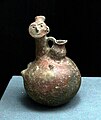Afyonkarahisar Archaeological Museum
The Archaeological Museum Afyonkarahisar is located in the Turkish provincial capital Afyonkarahisar in the Kurtuluş Caddesi 96. It displays finds from the Chalcolithic period about Hittite , Roman and Phrygian period to the Ottoman era.
history
In the 1920s, in the early years of the Turkish Republic, at the suggestion of the Asar-ı Atika Muhipleri Cemiyeti (Society of Lovers of Ancient Works), a warehouse for archaeological finds and monuments was set up in the Gedik-Ahmet-Pasha Medrese . On the initiative of the teacher Süleyman Gönçer, who was the chairman of the society, the madrasah was officially declared a museum in 1931. In 1933 the museum was opened on the tenth anniversary of the founding of the republic and Süleyman Gönçer was appointed director. As the number of objects in the collection increased and the museum contained both archaeological and Islamic artefacts, the space requirements grew steadily. As a result, it was moved to the current building on Kurtuluş Caddesi in 1971, which housed the Afyonkarahisar Museum Directorate. A museum for Islamic works of art was set up in the Gedik-Ahmet-Pascha-Medrese, which was renovated from 1978 to 1994, but had to close in 1996 because moisture damage to the building could no longer be repaired.
exhibition
Most of the exhibits come from the museum's own excavations in the area. The oldest pieces are Copper Age ceramic objects from the Kaklık Cave. Objects such as large grave vessels from the Hittite cemetery of Yanalar date from the Bronze Age. A bronze figurine from Ahurhisar and a stele from Kocaoğuz are also of Hittite origin . Sculptures from the Phrygian and Roman times come from İscehisar , Apamea and Synnada, where coins have also been found. A large number of statues depicting members of the Greco-Roman world of gods came to light at Kovalık Höyük near Çavdarlı. Other stone monuments, including Ottoman grave steles, are exhibited in the outdoor area of the museum. The museum keeps the remains of a painted wooden burial chamber from the Achaemenid period from the Tatarli tumulus , which are soon to be presented in a new museum.
In 2019, the museum had 44,383 exhibits, including 13,286 archaeological and 4,484 ethnological objects, 26,252 coins and 59 books and documents. The museum building is a single-storey structure with nine interconnected exhibition rooms. This also includes office space, a library, a conference room, storage rooms, a photo workshop and a laboratory.
Artemis statue
Web links
Individual evidence
Coordinates: 38 ° 44 ′ 51.7 ″ N , 30 ° 33 ′ 2.5 ″ E




